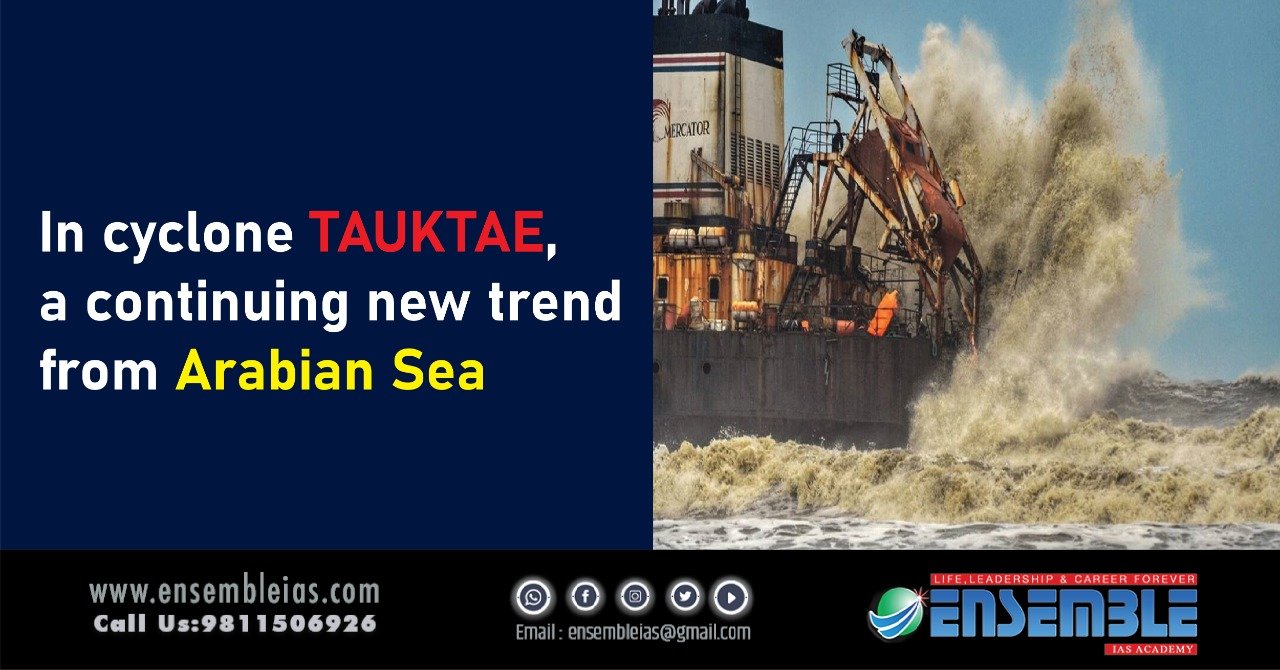In Cyclone Tauktae a continuing new trend from the Arabian Sea: Cyclone Tauktae (pronounced Tau-Te), classified as a very severe cyclonic storm (VSCS) and developed in the Arabian Sea, is expected to hit southern Gujarat on Tuesday. In recent years, strong cyclones have been developing in the Arabian Sea more frequently than earlier.
To buy our online courses: Click Here
As of 5.30 pm on Sunday, Cyclone Tauktae lay over 190 km northwest of Panjim, 270 km south-southwest of Mumbai, 510 km south-southeast of Veraval, 470 km south-southeast of Diu and 700 km southeast of Karachi. The system is expected to intensify during the next 24 hours.
As per the latest cyclone track forecast, Tauktae will cross close to Porbandar and Mahuva in Gujarat’s Bhavnagar district as a Very Severe Cyclone (VSCS) during the early hours of Tuesday, with an expected wind speed of 150-160 km/hr gusting to 175 km/hr.
Heavy to very rain and storms could affect at least 12 districts of Gujarat – Kutch, Saurashtra, Porbandar, Junagarh, Bhavnagar, Ahmedabad, Surat, Valsad, Amreli, Anand and Bharuch, and the Union Territory of Diu.
In Cyclone Tauktae a continuing new trend from the Arabian Sea:
Why is Cyclone Tauktae unique?
Tauktae is the fourth cyclone in consecutive years to have developed in the Arabian Sea, that too in the pre-monsoon period (April to June). All these cyclones since 2018 have been categorised either ‘Severe Cyclone’ or above. Once Tauktae makes its landfall, three of these will have hit either the Gujarat or Maharashtra coast. After Cyclone Mekanu in 2018, which struck Oman, Cyclone Vayu in 2019 struck Gujarat, followed by Cyclone Nisarga in 2020 that struck Maharashtra.
Tauktae has been intensifying very rapidly. From a depression formed in the southeast Arabian Sea on May 14 morning, it strengthened into a VSCS by the early hours of May 16. Compared to Tauktae’s 2 days, Cyclone Vayu had taken 36 hours to become a VSCS, while Cyclone Mekanu (4 days) and Cyclone Nisarga (5 days) had developed slower.
Also, the first cyclones to form in 2020 and 2021 were in the Arabian Sea during the pre-monsoon period, both in the VSCS category.
What is aiding such rapid intensification?
Any tropical cyclone requires energy to stay alive. This energy is typically obtained from warm water and humid air over the tropical ocean. Currently, sea water up to depths of 50 metres has been very warm, supplying ample energy to enable the intensification of Cyclone Tauktae.
The more the heat released through condensation of water vapour, the steeper the drop in pressure. A low-pressure system undergoes multiple stages of intensification to form cyclones.
Typically, tropical cyclones in the North Indian Ocean region (Bay of Bengal and Arabian Sea) develop during the pre-monsoon and post-monsoon (October to December) periods. May-June and October-November are known to produce cyclones of severe intensity that affect the Indian coasts.
Also Read: Can a single lightning flash kill 18 elephants? Science says yes, in various possible ways:
Is the Arabian Sea becoming cyclone-friendly ?
Annually, five cyclones on average form in the Bay of Bengal and the Arabian Sea combined. Of these, four develop in the Bay of Bengal, which is warmer than the Arabian Sea. In the Arabian Sea, cyclones typically develop over Lakshadweep area and largely traverse westwards, or away from India’s west coast.
However, in recent years, meteorologists have observed that the Arabian Sea, too, has been warming. This is a phenomenon associated with global warming.
(In Cyclone Tauktae a continuing new trend from the Arabian Sea)




